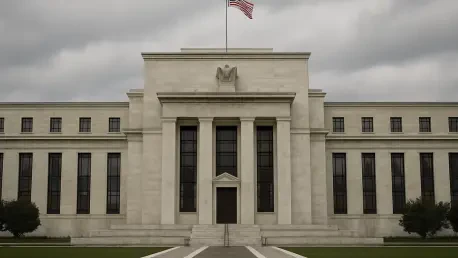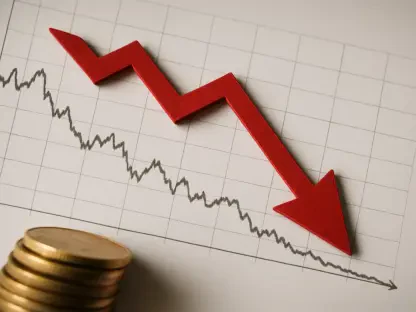In the complex and ever-evolving world of global markets, the Federal Reserve’s dovish posture in the current year has carved out a distinctive set of opportunities and hurdles for commodity investors seeking to maximize returns. With the federal funds rate anchored at 4.25% and subtle indications of potential rate reductions by the end of the year, the Fed’s measured approach is subtly altering the demand dynamics for commodities priced in U.S. dollars. A marginally weaker dollar, despite a slight uptick in its index, generally creates a favorable backdrop for commodity price growth, as these assets become more accessible to international buyers. However, this seemingly supportive environment is layered with complexities, as macroeconomic indicators, geopolitical frictions, and sector-specific variables interplay to shape market outcomes. Investors are tasked with deciphering this intricate puzzle, balancing the broader monetary policy signals with localized disruptions to pinpoint where true value lies in a fragmented commodity landscape.
Decoding the Federal Reserve’s Dovish Influence
The Federal Reserve’s dovish stance often translates into expectations of lower interest rates, which can depress the value of the U.S. dollar and make commodities more attractive to global investors. In the current climate, even with a minor strengthening of the dollar index, the overarching trend of relative softness provides a tailwind for many commodity prices. This dynamic reduces the cost burden for foreign purchasers, potentially spurring demand across various sectors. Yet, this monetary policy effect does not cast a uniform glow—while certain commodities bask in heightened interest, others grapple with counteracting forces such as oversupply or geopolitical barriers. Understanding the nuanced transmission of the Fed’s policy through financial markets becomes paramount for investors aiming to position themselves advantageously amid these shifting tides.
Beyond the immediate currency implications, the Fed’s cautious approach to rate adjustments also influences broader economic sentiment, which in turn affects commodity demand. A dovish policy often signals an intent to stimulate growth, potentially increasing industrial activity and consumption of raw materials. However, with hints of rate cuts still on the horizon, uncertainty lingers over the timing and magnitude of such moves, creating a wait-and-see attitude among market participants. This hesitancy can lead to choppy price movements in commodities, as traders react to every Fed statement or economic data release. For those navigating this space, staying attuned to central bank communications and their ripple effects on inflation expectations and growth forecasts is critical to anticipating market shifts and aligning investment strategies accordingly.
Sectoral Trends and Market Divergences
Drilling down into specific commodity sectors reveals a mosaic of trends that defy a one-size-fits-all narrative. Industrial metals, particularly copper, are experiencing a significant upswing, with prices reaching a 12-month high due to supply constraints exacerbated by steep tariffs on imports. This surge is further bolstered by sustained infrastructure spending in the U.S., which fuels demand for such materials. Conversely, agricultural commodities present a mixed picture—wheat prices are climbing due to adverse weather impacting key growing regions, while corn faces downward pressure from fluctuating export demand and yield uncertainties. Energy markets, like crude oil, are under short-term strain from reduced seasonal demand, though geopolitical tensions in critical regions provide a buffer against deeper declines. Each sector demands a tailored analytical lens to discern where opportunities outweigh risks.
Adding to the complexity, precious metals like gold remain caught in a tight trading range, influenced by the tug-of-war between dollar strength and their role as a hedge against inflation and geopolitical unrest. While potential rate cuts could ignite renewed interest in gold, the lack of clear policy direction keeps prices in limbo, requiring investors to watch technical levels closely for breakout signals. Meanwhile, livestock markets encounter seasonal supply pressures that dampen upside potential, and soft commodities such as cotton hover in a state of inertia, vulnerable to sudden trade policy shifts. This patchwork of performance underscores the necessity of a detailed approach, where broad economic tailwinds must be weighed against the unique fundamentals driving each commodity group to craft effective investment plays.
The Geopolitical and Policy Landscape
Geopolitical risks and trade policies stand as formidable forces shaping the commodity arena in the current market cycle. Aggressive tariffs, such as the 50% levy on refined copper imports, are not isolated to one sector but send shockwaves through multiple markets, tightening supply expectations and sparking speculative buying. These policy measures, often enacted with little warning, introduce significant volatility, as seen in potential disruptions to supply chains for soft commodities like orange juice and cotton, should U.S.-China trade tensions escalate further. Such actions often overshadow macroeconomic signals, forcing investors to recalibrate their expectations and risk assessments in real time to stay ahead of sudden market pivots.
Beyond tariffs, broader geopolitical uncertainties, including ongoing tensions in the Middle East, continue to underpin energy market dynamics, preventing crude oil prices from collapsing despite seasonal softness. Decisions by OPEC+ regarding production levels add another layer of unpredictability, as coordinated cuts or unexpected increases can swiftly alter price trajectories. For commodity investors, the challenge lies in anticipating these external shocks, which can derail even the most robust strategies rooted in economic fundamentals. Keeping a finger on the pulse of international relations and policy announcements becomes essential, as these factors can rapidly transform a calculated investment into a high-stakes gamble.
Strategic Moves for Market Success
Navigating the commodity space in this dovish Fed environment calls for a blend of agility and strategic foresight. Bullish opportunities shine in sectors like copper and wheat, where supply tightness and weather-driven demand create compelling cases for long positions. On the flip side, short-term weaknesses in crude oil and corn, driven by seasonal lulls and policy uncertainties, offer potential for bearish plays that could yield gains if timed correctly. Gold presents a more nuanced picture, with its trajectory tied to the Fed’s eventual rate decisions—investors might consider conditional trades based on price breakouts or breakdowns at key technical thresholds, ensuring flexibility in response to evolving signals.
Equally important is the need for caution in sectors with limited upside, such as livestock and soft commodities, where seasonal pressures and vulnerability to trade disputes temper enthusiasm. A successful approach hinges on marrying an understanding of overarching monetary policy trends with deep dives into sector-specific drivers, allowing for tailored risk management. Investors must remain adaptable, ready to pivot as new data on Fed intentions, geopolitical developments, or supply-demand shifts emerge. By maintaining this dual focus on the macro and micro, it becomes possible to exploit the diverse opportunities scattered across the commodity spectrum while mitigating the inherent risks of a volatile market landscape.
Reflecting on Tactical Pathways Forward
Looking back on the intricate interplay of forces in the commodity markets during this dovish Fed period, it is evident that a supportive monetary backdrop has laid a foundation for potential price appreciation across various sectors. The challenges posed by geopolitical frictions and policy unpredictability tested the resilience of even the most seasoned investors, as tariffs and international tensions reshaped supply expectations with little notice. Sectoral disparities, from copper’s rally to oil’s softness, highlighted the fragmented nature of opportunities that defined this cycle. Moving forward, the emphasis should rest on developing dynamic strategies that can adapt to sudden shifts, leveraging real-time data to refine positions. Prioritizing risk management alongside opportunity hunting ensures that gains are protected against unexpected downturns, offering a balanced path through the complexities of this market environment.









